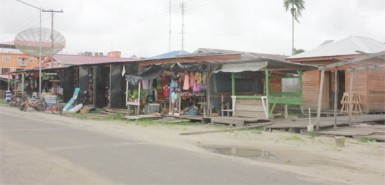Region Two officials are concerned about the quality of rice to be produced this season as paddy bugs have re-appeared just as the new crop has started to mature.
Region Two Chairman Parmanand Persaud told Stabroek News recently that finding a more effective way to combat the pest was among the regional administration’s highest priorities.
Last year and earlier this year, Essequibo coast farmers were despairing that a paddy bug infestation took a serious toll on the quality of rice produced. The situation earlier this year led to three days of protests by farmers over the low prices being paid to them at the rice mills.

Though production levels earlier this year were the highest in some time, the lower grades of rice translated to the lower prices seen at the rice mills as the millers refused to pay high prices for the damaged produce.
As a result, while farmers in Berbice and other areas were enjoying as much as $3,500 to $4,000 per bag, rice farmers in Essequibo were receiving as little as $1,000 per bag, Region 2 Executive Officer Anil Singh said. He, however, did note that some received close to $4,000, depending on the quality of their produce.
Commenting on the problem earlier this year, Agriculture Minister Dr Leslie Ramsammy, in a statement, said that all areas where rice farming was practised was affected by the bug, though, for unknown reasons, the pest damage was evidently more acute in Region Two. However, he added that it appeared that the problem was being experienced by a “small group” of farmers.
Both the adult bugs and nymphs feed on rice grains during various stages of its maturity. This feeding causes empty or small grains during the milking stage. When the grains reach the hard dough stage, feeding by the paddy bugs can cause grains to be deformed. The grains become dark as a result of the spilling of endosperm (tissue produced at the time of fertilisation), which can become a medium for fungal infection.
Persaud said that after the problem arose, officials from the Guyana Rice Develop-ment Board (GRDB) were sent to the region at the behest of Ramsammy to formulate a strategy, along with the region’s officials and its farmers, to address the pest problem.
Singh said that the problem faced is complex, particularly due to the unpredictable weather patterns seen recently. He said that in the past, spraying the crops with a particular insecticide has proved effective. He said that using pre-existing weather patterns, farmers could predict when they were due to have limited rain and spray during this time.
Spraying while the rains are heavy is obviously out of the question, he said, since the insecticide would be washed away.
With exceedingly variable weather now, farmers often spray in anticipation of prolonged dry weather, only to be surprised by heavy rainfall.
Singh also said that the unusual rainfall patterns affect the region’s ability to do particular maintenance works. He said that the dry seasons are traditionally used to maintain the dams which provide access to the region’s many rice fields. Such works, he said, cannot be carried out during the rains since the task is made impossible by the muddy, slushy conditions, which can damage their equipment. One dredge, he said, was even stranded due to such conditions.
Singh shared that though the region is supposed to be in the middle of a dry season, the rains have not yet ceased. As such, they have not been able to carry out necessary work to the dams.
Singh, Persaud, and the Town Clerk of Anna Regina, Diane Critchlow also said that flooding was one of the region’s biggest issues.
There are several situations which lead to flooding and Critchlow said that some of the residents are to blame. Aside from dumping of refuse into drains and canals, she said that some of the structures which residents construct over drains impede the flow of water, preventing effective drainage.
She said that vending stalls, in particular, are built over the drains by vendors, who fail to remove them even after they abandon the structure. The municipality, she said, is taking steps against such persons to the extent that security deposits which are lodged by persons for building these structures are only returned if they remove the structure when they leave.
She said that poor drainage is compounded by the growth of vegetation in canals as well as the drains surrounding residences. She said that the regional council assists the municipality by providing an excavator to clear the canals, since the town’s own machine has been down for the past two years.
In the case of clogged drains around persons’ houses, she said that a policy has been implemented where leases for lands now require its owner to take care of the drainage in their immediate surroundings.
Singh said that mud deposits along the region’s sea defences also lead to flooding. He added that the deposits come right up to kokers, inhibiting the flow of water back into the river. He said that a dredge given to the region by the Works Ministry helps to remove the deposit, although it tends to re-accumulate at a fast pace.
He also said that the region is not in possession of enough pumps to get rid of floodwater as fast as they would like to. Notwithstanding this, he said that the measures currently being employed by regional officials are going a far way, and added that while there is flooding, the impact is not very substantial.





